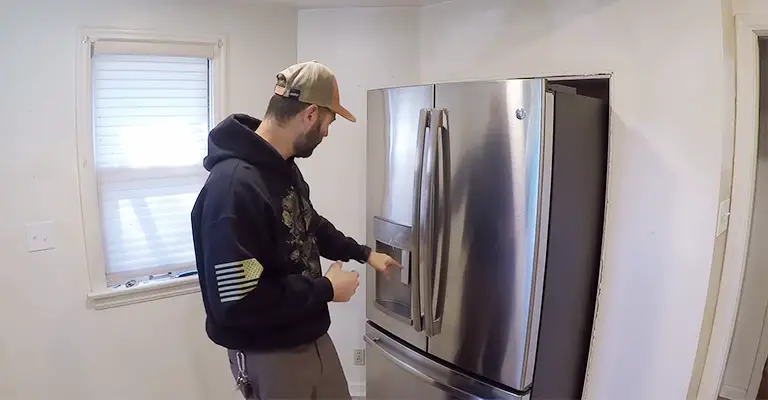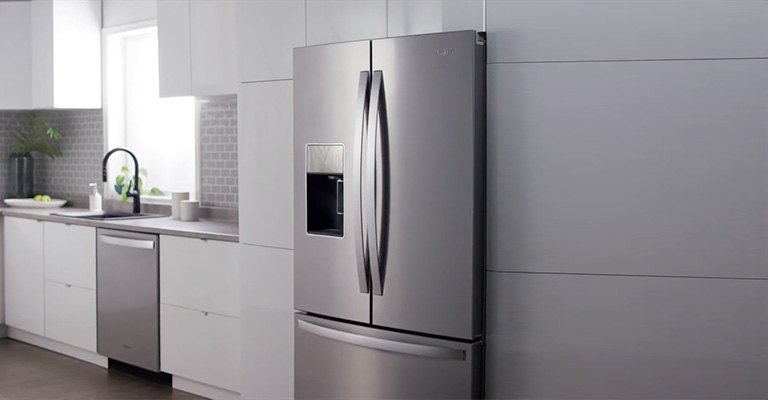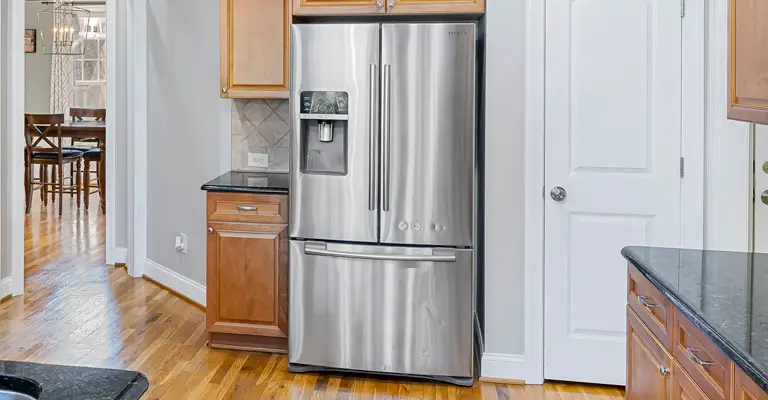Refrigerator ventilation is not just about convenience or aesthetics; it’s a critical aspect of ensuring your appliance operates efficiently and has a longer lifespan.
Without proper ventilation, your fridge may struggle to maintain the right temperature, leading to higher energy bills and potential damage.
So, whether you’re a home improvement enthusiast or simply want to make the most of your kitchen’s layout, understanding how much space your refrigerator needs for ventilation is essential.
Ensure that your refrigerator has good air flow. If your fridge is not properly ventilated, it can malfunction and consume more energy.
For ventilation, the refrigerator needs at least a quarter-inch gap on the sides and a one-inch gap on the back and top.
Understanding Ventilation Space For A Refrigerator
As a first step, you should consult the instructions provided by the manufacturer. For things like clearances, etc., that is the only source of accurate information.
The coils and fans are located in different places in the refrigerator, so this entirely depends on where they are located. Refrigerators from the past used fins on the back to cool, and depended on convection (heating from below).
During the summer, the coils would generate heat that would pull air through the lower grille, up the back, and over the top. Most modern units cool by using a fan to push heat out of the bottom plate at the front of the device.
I think there is certainly a need for some clearance on the sides, especially now that some have vents on the sides as well. In my opinion, each side should be at least 1/2 inch. It is also rare for freestanding refrigerators to be perfectly plumb.
Have you considered putting the refrigerator inside a cabinet? Put a level beside one and see for yourself. In the body, the plastic and spray insulation cause the sides to bow out, which can cause fit issues.
Several inches of space are required at the back of older refrigerator models for ventilation. Newer models allow you to leave about one to two inches of space on all sides and on top.
How Much Ventilation Does A Refrigerator Need?

In order for refrigerators to vent properly, they need at least two to three inches of space. It is especially important for older models because restricted airflow can reduce their efficiency.
With newer models, you have more leeway. Although it may be tempting to stuff your fridge into a small space, ensure that there is at least two inches of clearance on all sides.
If you do not do this, your fridge will have trouble keeping its set temperature at all times.
Why Does A Refrigerator Need Ventilation?
Your refrigerator’s airflow can be restricted by insufficient ventilation. The refrigerator components can overheat if there is insufficient circulation of cool air. This may lead to premature failure of the refrigerator.
Due to overheating, the refrigerator’s compressor has to work harder to keep the food cool. Insufficient ventilation increases the refrigerator’s energy consumption. Your electricity bill spikes due to energy inefficiency.
Airflow restrictions were not a problem because the coils of fridges were located at the back, so many homeowners kept them away from walls.
The situation has changed, however. Due to this, most people don’t give their refrigerators enough air to breathe.
Other Important Refrigerator Measurements You Need to Know

If you’re purchasing a refrigerator, make sure that it’s a perfect fit for your lifestyle and packed with features you’ll love.
Nevertheless, you need to ensure that the refrigerator can fit perfectly into your home before you make that purchase.
1. Measure The Refrigerator Space
There are a variety of refrigerators to choose from. It doesn’t mean a new refrigerator will fit in your kitchen just because you already have one that fits.
Because of this, you must take measurements before purchasing a new model. The space where the refrigerator will be installed should be measured in three dimensions: width, depth, and height.
If there are any obstacles obstructing the delivery path, such as doorways, stairs, or tight corners, ensure that they are measured. If you want to be sure that you have the exact dimensions, it doesn’t hurt to measure an extra time.
You may not have taken the dimensions of your home when you moved in, and the measurements will likely change over time.
2. Identify The Door Swing
If you want to open the refrigerator door fully, you need to consider how much space you have. To access all areas of a refrigerator, it is often necessary to open it 90 degrees or more.
You should check the specific installation requirements of the refrigerator you are considering since the space necessary for a door swing varies from one style to another.
In comparison to a side-by-side refrigerator, a top freezer requires a different amount of space to open fully.
3. Counter-Depth vs. Standard Depth Refrigerators
If you are choosing a refrigerator for your home, you should also consider how it will look once it is installed. Freestanding refrigerators can be divided into two types.
There are two types of refrigerators: counter-depth refrigerators and full-depth refrigerators, whose depth is greater than your counter.
Counter-depth is the best option if you want your kitchen to appear sleek and built-in. The depth of Counter-Depth refrigerators matches the depth of your counters, with a standard case depth of 24 inches.
It is also common for these refrigerators to be taller to compensate for their smaller depth, and typically they have less capacity than their full-depth counterparts.
If you aren’t concerned about the fridge’s depth exceeding the counter’s depth, then a Proud refrigerator is a good choice.
4. Measure The Delivery Path
Doorways, staircases, and any other areas that the refrigerator may bump into are the last areas you need to measure before purchasing your new refrigerator.
A refrigerator that won’t fit through your front door would be the worst thing that could happen.
How Can I Extend The Lifespan Of My Refrigerator?

Besides increasing the refrigerator’s lifespan with proper ventilation, you can also take these steps to help prolong its lifespan:
Seal Up Any Gaps
If there are gaps in your refrigerator, cool air can escape, overworking its components to maintain set temperatures.
Ensure that the rubber guards on your fridge door don’t have any holes to prevent this. Whenever you are not using the fridge, close it.
Adjust The Temperature
In an effort to keep food cool, it may be tempting to set the fridge to the lowest temperature. However, that’s not a good idea. In order to maintain that temperature, the refrigerator has to work harder.
Keeping your fridge at a temperature of three or four degrees Celsius will prevent your fridge’s motor from overworking. By doing this, you can avoid excessive wear and tear and save on electricity.
Make sure the fridge door isn’t left open for an extended period of time. In order to maintain the set temperature, the fridge’s motor works harder when the cool air escapes. As a result, the motor wears out more quickly.
Avoid Putting Too Much Inside
The overstocking of your refrigerator can impede its air circulation, preventing it from maintaining a steady and cool temperature.
Furthermore, the fridge shelves can only support a certain amount of weight. When the shelves are overloaded, they may fall, leading to accidents or other damage inside the refrigerator.
Make sure you check the user manual of your refrigerator to find out its capacity. There is always a maximum amount of food that can be stored in a refrigerator model stated by the manufacturer.
Clean Regularly
A refrigerator’s ventilation clearance can quickly build up dust and dirt. Inefficient cooling is caused by allowing dirt to accumulate in the fridge’s cooling system.
Every three to four months, you should clean your fridge. It dramatically improves the airflow in the refrigerator by keeping it smelling and looking clean.
Keep It Away From Sources Of Heat
A refrigerator’s lifespan is reduced when it is exposed to direct sunlight or heat from a stove. In other words, place the refrigerator in an area that is cool and away from sources of heat.
Keeping the refrigerator cool will be harder if the refrigerator is placed near a heat source.
In the long run, this may result in compressor failure, which will require costly repairs or new fridge purchases.
Proper Maintenance
In order to keep your fridge’s components working properly, it is important to perform regular maintenance. The refrigerator will last fourteen to seventeen years if you do this.
Ensure that coils and hoses are in good condition by checking them regularly. If you want to check the refrigerator’s condition, you can hire a professional.
Furthermore, they are able to help you repair or replace defective components if you are not confident or lack the technical knowledge.
Can I Place Things On Top Of The Refrigerator?
Things are often left on top of refrigerators by many people. These include books, fruit baskets, cereal boxes, and much more. If you want to store things on top of the fridge, it would be best not to do so.
A refrigerator’s ventilation can be affected by it, for instance. There are several factors that can lead to problems with your fridge, even if they are not immediately apparent.
You are also more likely to have an accident in the kitchen if you leave things on top of the fridge. If someone tries to open the refrigerator, items like medicine bottles, books, and other objects may fall on them.
Furthermore, the temperature of a refrigerator can directly influence the quality of perishable items, such as wafers, cookies, and cereal. It can even cause a fire in some extreme cases.
Final Words
For refrigerators to ventilate effectively, there must be at least two to three inches of space around them. The older refrigerator models have back-mounted cooling coils, making this imperative.
Cooling coils are located underneath modern refrigerators. In this way, they can fit into tighter spaces more easily, though you still need to allow at least two inches of space all around them in order for them to perform at their best.








